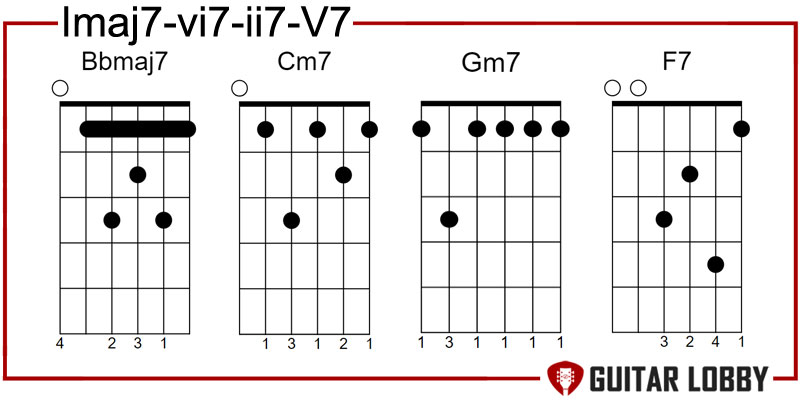Jazz is all about fluid, ever-evolving creative expression that allows you to push the envelope and grow as a musician. And while learning jazz standards is a great way to make your foray, getting a good grounding in the standard chord progressions will go a long way in allowing you to explore endless melodic and harmonic possibilities.
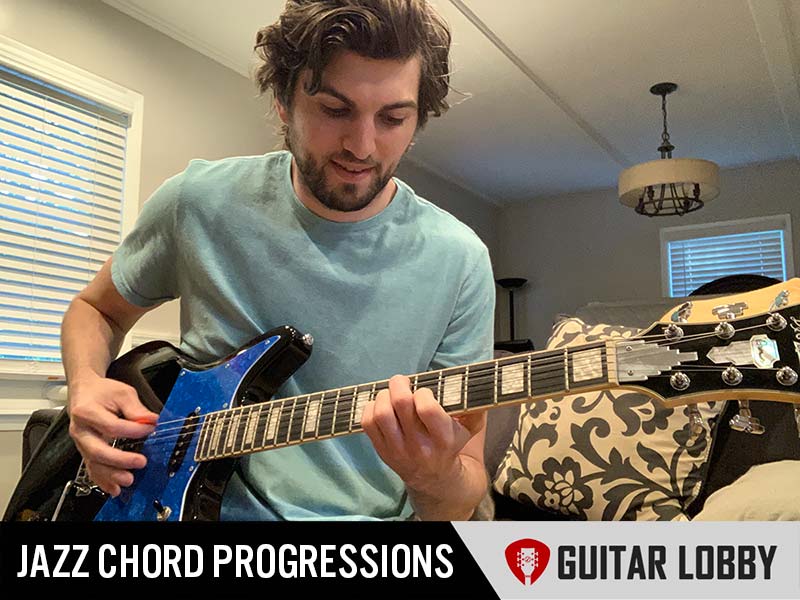
You could play around and improvise with these progressions before moving on to comping, soloing, or even writing your own jazz melodies. Today, I’ll be walking you through 25 of the most common jazz chord progressions. We’ll also look at some of them in action with real-life examples. After learning some of these progressions, head over to our list of easy jazz guitar songs to play, and you’ll notice many of these progressions used in them.
Table of Contents
- 1. ii – V – I
- 2. ii – V – i
- 3. Imaj7 – Imaj7 – ii7 – V7 Descending ii – V – I
- 4. I – vi – ii – V
- 5. i – vi – ii – V
- 6. Imaj7 – vi7 – ii7 – V7 Rhythm Changes Progression
- 7. iii – VI – ii – V
- 8. III7 – VI7 – II7 – V7 Rhythm Changes Bridge Jazz Progression
- 9. Imaj7 – #I°7 – ii7 – #II°7 – VI7 Diminished passing chord
- 10. I – IV
- 11. IVmaj7 – iv7
- 12. i7 – i7/b7 – bVI7 – V7
- 13. ii – V Chains
- 14. Tritone Substitution
- 15. I7 – IV7 – I7 – I7 – IV7 – IV7 – I7 – VI – ii – V – I7 – (ii – V) Jazz Blues Progression
- 16. Bird Blues Chord Progression
- 17. I – VI – ii – bII
- 18. iv7 – bVII – I Backdoor Progressions
- Chord Progressions Found in Jazz Standards – 7 Examples
- 19. Blue Bossa
- 20. Autumn Leaves
- 21. Girl from Ipanema / Take the A Train
- 22. Stella by Starlight
- 23. West Coast Blues
- 24. Satin Doll
- 25. Misty
1. ii – V – I
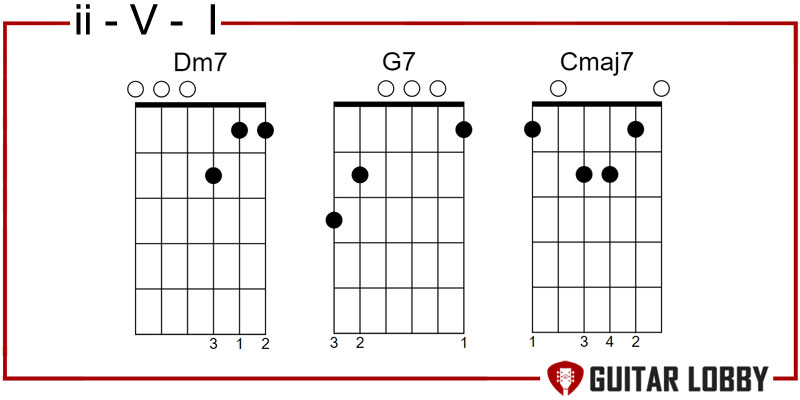
The II – V – I or 2 – 5 – 1 is the bedrock of jazz songwriting. You’ll find it in countless jazz standards, in its basic form, as well as in fascinating variations and voicings. And that’s why it is the first chord progression on this list.
The 2-5-1 exists in both major and minor forms. In its major form, the ii – V – I kicks off with the ii chord (a minor 7th chord), followed by a V chord or a dominant, and finally, the I chord, which is a major 7th chord. The complete progression looks like ii7 – V7 – I7.
Together, the chords drive a song forward, giving listeners a strong feeling of resolution. The chords in this sequence are diatonic chords, as they belong to the same scale. In C major scale, this sequence becomes Dm7 – G7 – Cmaj7.
If you’re serious about a jazz guitar journey, I cannot recommend a better starting point than the ubiquitous 2- 5 – 1. This sequence has powered iconic jazz tunes either in its simplest form, by utilizing the circle of fifths as a turnaround, or even as a part of a much bigger chord progression (like Autumn Leaves).
When you get down to learning it, make sure to practice in all 12 keys and later spice it up by substituting chords, flipping them (inversions), or adding extended chords.
Popular Songs That Use This Progression: “Summertime” (George Gershwin) “Alone Together” (Howard Dietz and Arthur Schwartz).
2. ii – V – i
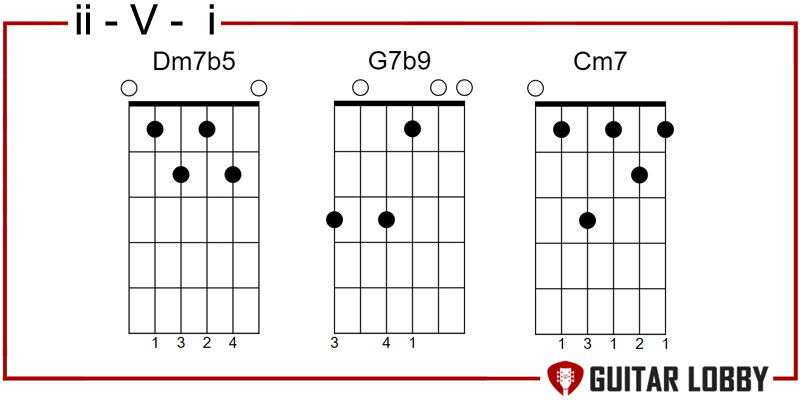
The famous 2 – 5 – 1 progression can be constructed in the major as well as the minor key. In a minor key, the most common version of this sequence is ii7b5 – V7 – i7. It goes without saying that the chord qualities of this progression in a minor key are different than those in a major key. It also sounds more dissonant and classy compared to its major counterpart.
In the C natural minor scale, the ii chord is the D half diminished 7th chord or Dm7b5 with D, F, Ab, and C notes. You can alter the dominant chord with an added flattened ninth or b9 to make this progression sound good and increase the harmonic tension. The chord sequence would then look like Dm7b5 – G7b9 – Cm7.
This progression sure is trickier than its major counterpart since it has a dominant 7th flat 9th chord, and the ii chord has a flattened fifth. But be patient and don’t skip it. After all, this progression is essential to expanding your repertoire of jazz tunes. It’s a good idea to practice it in all keys, along with learning songs that feature minor 2 – 5 – 1. I’ve listed a few of those tunes below.
Popular Songs That Use This Progression: “Yesterdays” (Ella Fitzgerald), “Autumn Leaves” (Bill Evans), “Tune Up” (Miles Davis).
3. Imaj7 – Imaj7 – ii7 – V7 Descending ii – V – I
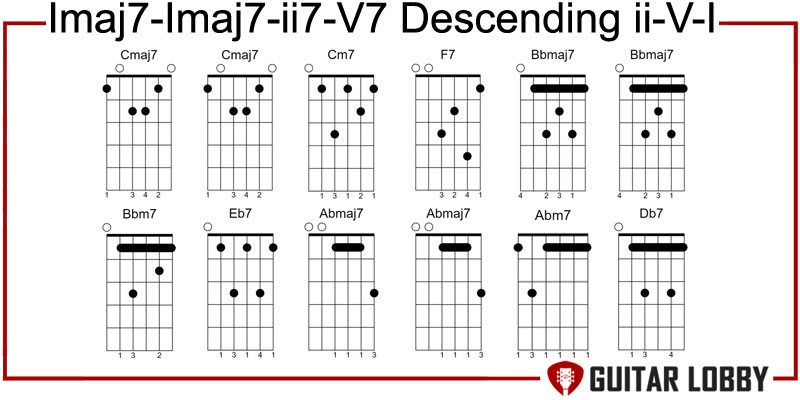
While we’re on the topic of the 2 – 5 – 1, here’s another version of the famed sequence that has made its way into most jazz jam circles. It’s known as the descending ii – V – I. In many jazz tunes, this progression starts with the Imaj7 chord for two bars, followed by the ii7 chord and the V7 chord. It then repeats the same chords over and over, each time with the tonality descending in whole steps.
Let’s say this sequence starts with the C major key, and there are two modulations (change from one tonality to another). Then, an example of this progression will see the key shift down from C major to Bb major and finally to Ab major. The entire sequence would look like this:
Cmaj7 – Cmaj7 – Cm7 – F7 – Bbmaj7 – Bbmaj7 – Bbm7 – Eb7 – Abmaj7 – Abmaj7 – Abm7 – Db7.
While it’s most notably used in Morgan Lewis’ iconic slow ballad “How High the Moon,” the descending ii – V – I can also be seen in action in “Tune Up” by Wes Montgomery and “One Note Samba” by Charlie Byrd.
Popular Songs That Use This Progression: “How High the Moon (Morgan Lewis), “Tune Up” (Wes Montgomery), “Cherokee” (Tal Farlow), “One Note Samba” (Charlie Byrd).
4. I – vi – ii – V
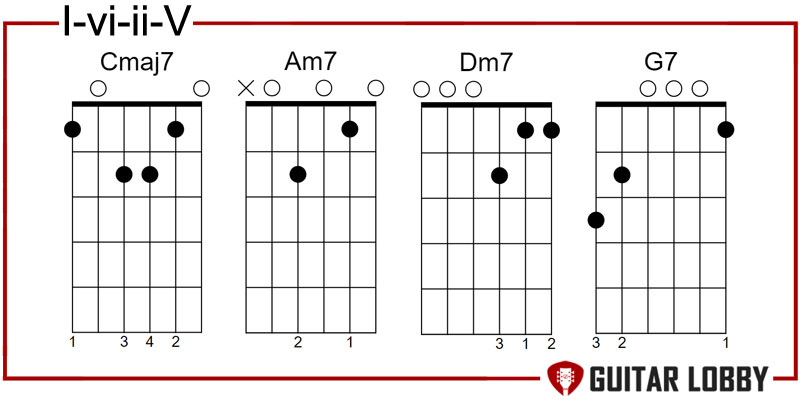
Another super popular jazz progression is the I – vi – ii – V or the 1- 6 – 2 – 5. Like 2 – 5 – 1, this sequence exists in both major and minor form. Perhaps the best example of the I – vi – ii – V that comes to mind is George Gershwin’s legendary jazz composition “I Got Rhythm.” In the song, the progression takes the shape of Imaj7 – vi7 – ii7 – V7. Since then, it’s been a part of many Rhythm Changes progressions modeled after Gershwin’s famous tune.
The I – vi – ii – V is also frequently used as turnarounds. In jazz, the job of a turnaround is to return the sequence to the tonic key. These progressions are usually found at the end of a section. In the key of C major, this sequence or turnaround would have the following group of chords: Cmaj7 – Am7 – Dm7 – G7.
You can either play it as is or change the iv chord or Am7 chord to the A7 chord. Why? Well, because it’s jazz! And jazz musicians love to play around with chords to surprise their audience. They challenge the norms of musical theory where the vi chord is a minor chord in every major key.
Instead of playing it as a minor chord, jazz artists turn it into a dominant chord by adding a major 3rd and a minor 7th. It acts as a surefire way to zhuzh up the tune, adding more flavor to make it memorable for the listeners.
Popular Songs That Use This Progression: “Oleo (Miles Davis), “Moose the Mooche” (Charlie Parker), “Cheek to Cheek” (Ella Fitzgerald and Louis Armstrong).
5. i – vi – ii – V
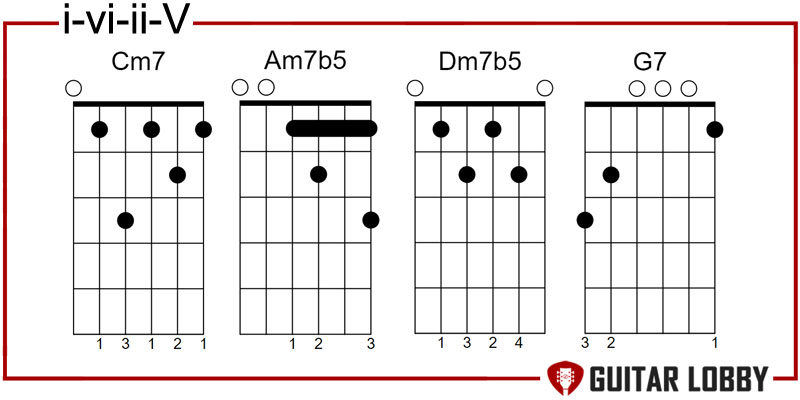
As with other common jazz progressions, the 1 – 6 – 2 – 5 occurs in the minor key as well. It’s often used as a turnaround, like its major cousin, bringing a mysterious and slightly bluesy vibe to the table. The different chord qualities also make it trickier to master.
A four-chord progression means more movement, and the fact that this one has two half-diminished chords makes it more challenging than the 2 – 5 – 1. But it’s pretty important to get under your fingers to improv like a jazz pro.
In the key of C minor, this progression takes the form of Cm7 – Am7b5 – Dm7b5 – G7. Note that Am7(/b5) and Dm7(b5) are the two half-diminished chords that’ll require most of your attention. You could try arpeggiating them to make them sound good.
Popular Songs That Use This Progression: “Softly As in a Morning Sunrise” (Chet Baker), “Blues for Alice” (Charlie Parker), “Straight, No Chaser” (Thelonious Monk).
6. Imaj7 – vi7 – ii7 – V7 Rhythm Changes Progression
George Gershwin’s 1930 classic “I Got Rhythm” has been the fodder and fuel behind many jazz standards. It’s the ultimate tune to learn jazz improvisation and master Rhythm Changes – a repetitive 32-bar jazz progression based on the song’s AABA form and chord changes. The AABA means two verses followed by a refrain and a final verse. This 32-bar form largely implies that the 1-8, 9-16, and 25-32 measures are the same. Only the bridge section in the 17-24 measures stands out.
The chord progression in section A of “I Got Rhythm” follows the I – vi – ii – V with some chord substitutions. If you’ve jumped straight to this one, I suggest you glance through the number 5 on this list. The chords are mostly diatonic or built from the notes of the same key (Bb key as heard in Gershwin’s original).
In the Bb major scale, the progression becomes Bbmaj7 – Gm7 – Cm7 – F7, and the 8 bar progression in entirety looks like:
(Bbmaj7 Gm7) – (Cm7 F7) – (Bbmaj7 Gm7) – (Cm7 F7) – (Bb7 Bb7/Ab) – (Eb6/G Ebm6/Gb) – (Bb/F F7) – Bb
You may notice how some elements look as if they’ve been borrowed from outside the Bb key, like the Gb and Ab notes. You might also be wondering where the Eb6 and Ebm6/Gb have come from. Well, it so happens there’s modulation in this chord progression where the Bb key changes to the Eb key before going back to the Bb key. The Eb6/G and Ebm6/Gb chords act like the ii chord to return to F7.
Now, Rhythm Changes can be as simple or as tricky as you want them to be. Some jazz musicians get really creative with it. You can start by getting comfortable with its most basic form and jazz it up later with chord substitutions using chromatic motion and tritone sub. Stay with me as I break down these techniques later in the article.
Popular Songs That Use This Progression: “I Got Rhythm” (George Gershwin), “Mean to Me” (Barney Kessel), “Shaw Nuff” (Barney Kessel), “Isn’t It Romantic” (Tal Farlow).
7. iii – VI – ii – V
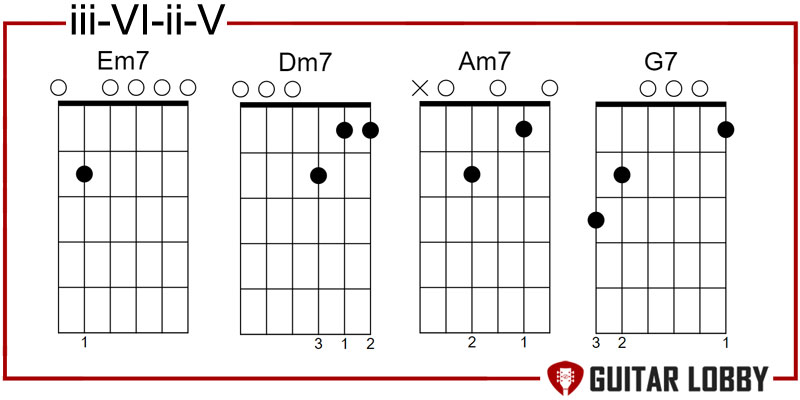
Next up is another interesting chain of chords: iii – VI – ii – V, used as turnarounds in countless tunes, including Rhythm changes. Doesn’t it look familiar? It’s like the 1 – 6 – 2 – 5, except we’ve replaced the I chord with the iii chord and turned the vi into the dominant 7th chord.
The minor iii chord stepping in place of the I chord happens a lot in jazz to break the monotony and add more color. You’ll often find this progression being used as iii7 – VI7- ii7 – V7. In Rhythm Changes, you’ll find this one played out in specific bars like 3-4 and 11-12 bars. If you look closely at the image, you’ll notice the Dm7 chord replacing the Bbmaj7 chords and Gm7 becoming G7 in those bars.
You can also keep everything the same as the I – vi – ii – V sequence and just replace the I (major 7th chord) with the iii chords to make iii – vi – ii – V. An example of this variation in the key of C major would involve the Cmaj7 getting swapped with Em7, making the new chain of chords Em7 – Dm7 – Am7 – G7.
Popular Songs That Use This Progression: “I Got Rhythm” (George Gershwin).
8. III7 – VI7 – II7 – V7 Rhythm Changes Bridge Jazz Progression
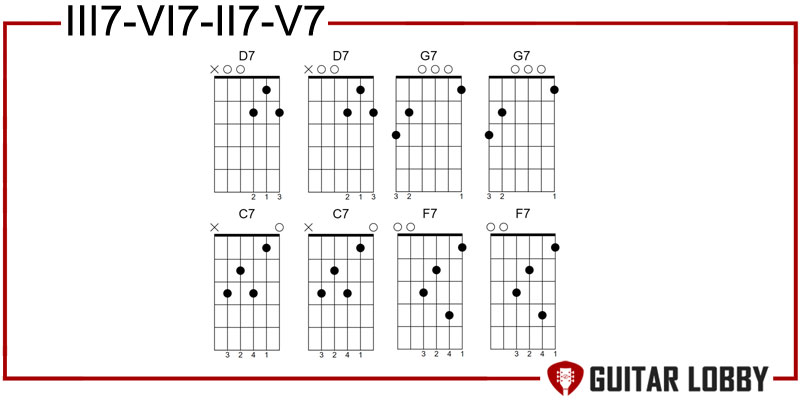
We looked at a Rhythm Changes variation in the previous example where the minor iii chord replaced the major seventh chord and the vi chord was made dominant to make iii7 – VI7 – ii7 – V7. In the bridge, the four-chord progression further changes, with the iii7 and ii7 chords turning into dominant chords that move along the circle of fourths.
The progression cycles from III7 to VI and II7 to V7, where each new chord resolves to the next chord while being played over two bars. This goes on till the V7 chord, which is F7 in Gershwin’s original key of Bb. Using the chords from the Bb major key, the bridge or section B of Rhythm Changes becomes D7 – D7 – G7 – G7 – C7 – C7 – F7 – F7.
Popular Songs That Use This Progression: I Got Rhythm’s bridge section (George Gershwin).
9. Imaj7 – #I°7 – ii7 – #II°7 – VI7 Diminished passing chord
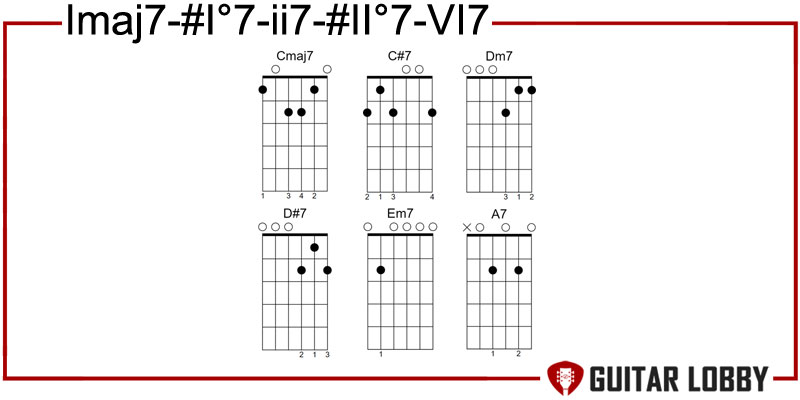
The reason jazz sounds so fluid is because of the diminished chords acting as passing tones. These passing chords are a great lever to go smoothly from one chord to another, especially if they are a whole step apart. It also adds harmonic tension and dissonance as a bonus.
For instance, if you were to go from Imaj7 to ii7 chords, you could smoothen the transition by adding a #I°7 chord or a diminished 7th chord. In the key of C major, this would involve going from Cmaj7 to Dm7 by passing through C#°7.
Still confused? Here’s another example. Say you want to go from ii7 to iii7 chord. Instead of leaping, you can add a #II°7 chord to elevate the sequence sonically. When you put these chords together, you get an ascending chromatic progression that looks like this Imaj7 – #I°7 – ii7 – #II°7 – VI7, which in the key of C major is Cmaj7 – C#°7 – Dm7 – D#°7 – Em7 – A7. Play the altered sequence to learn how awesome it sounds than if you were to skip the Dim7 chords. If you’re looking for jazz chord progressions to learn, this is one that I highly recommend.
Popular Songs That Use This Progression: “Cherokee” (Tal Farlow), “Have You Met Miss Jones” (Kenny Burell), “Ain’t Misbehavin’” (Django Reinhardt).
10. I – IV
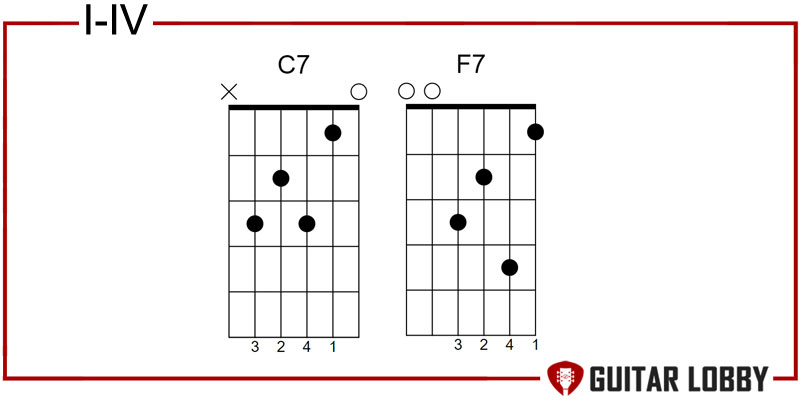
This basic two-chord progression is common across genres, from pop to jazz to blues. To the listeners, the harmonic movement of moving by a perfect fourth interval gives a sense of forging ahead. There are different ways of going from the I chord to the IV chord. It can either be a direct jump from I to IV diatonically, like going from C to F or C7 to F7 in the same key. It could also involve taking a detour by going through the V7 chord or even a ii – V or ii – V – I progression before finally getting to the IV chord. In other words, this simple two-chord progression is a blank canvas that can accommodate fascinating harmonic variations.
It’s a good idea to get comfortable with the concept of the movements by fourths to understand the relationship between I and IV chords and use it to broaden your jazz as well as blues repertoire. “C Jam Blues” by Red Garland Trio is a stellar example of this harmonic movement. You can also sample this progression in “Cherokee” by Tal Farlow.
Popular Songs That Use This Progression: “Joy Spring” (Joe Pass), “Sweet Georgia Brown” (Miles Davis), “Cherokee” (Tal Farlow), “Have You Met Miss Jones” (Kenny Burrell).
11. IVmaj7 – iv7
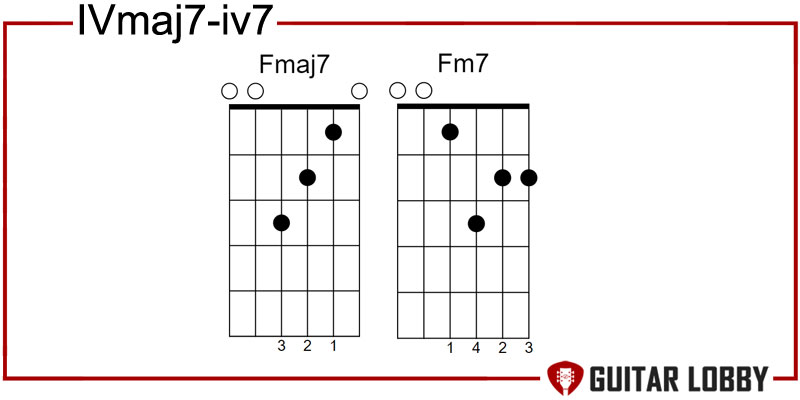
Instead of adding a host of jazz tunes to your must-know list, learn the most common progressions that dominate the genre. Like every other musical style, understanding a few chord relationships and basic sequences will help you create your own melodies spontaneously like an improv pro. This brings us to another harmonic movement that keeps showing up in jazz along with the likes of ii – V – I, I – iv – ii – V, and I – IV.
I am talking about the progression that takes you from the IV major chord to the iv minor chord or IVmaj7 to iv7. The jazz standard “All of Me” employs this progression. You can also hear it in “There Will Never Be Another You” and “All the Things You Are.”
If you were to play this in the Key of C major, you’d be starting with an Fmaj7 chord and then jumping to an Fm7. Clearly, no song would be based entirely on a simple two-chord movement, but you’ll find it a part of larger progressions.
Popular Songs That Use This Progression: “All of Me” (George Benson), “All the Things You Are” (Pat Metheny), “Moose the Mooche” (Pat Metheny).
12. i7 – i7/b7 – bVI7 – V7
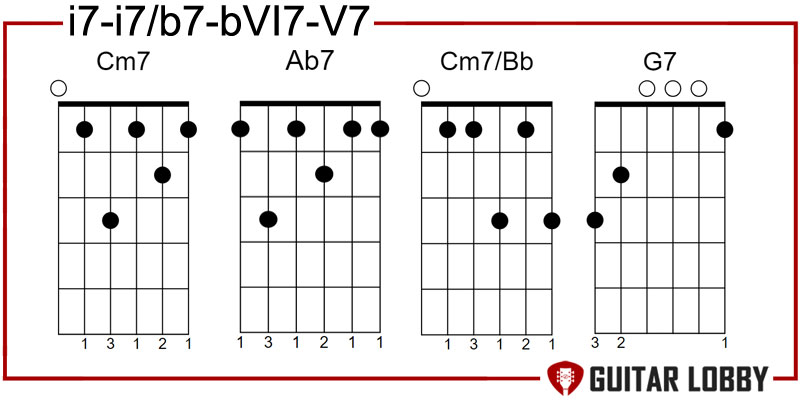
This interesting chord sequence was made famous in the jazz circles by a rockabilly band. Stray Cats’ “Stray Cat Strut” featured a four-chord progression that became a template for writing minor-key turnarounds. The band did a brilliant job blending jazz and blues and presenting it in a rockabilly setting.
As strange as it looks, the i7 – i7/b7 – bVI7 – V7 is pretty simple to play. Plus, it instantly adds color and richness to the melody. Since the song is written in the key of C minor, the four chords that make up the sequence are Cm7 – Cm7/Bb – Ab7 – G7.
This cool, bluesy progression is a must-know to build a solid foundation in comping or soloing in jazz.
Popular Songs That Use This Progression: “Stray Cat Strut” (The Stray Cats).
13. ii – V Chains
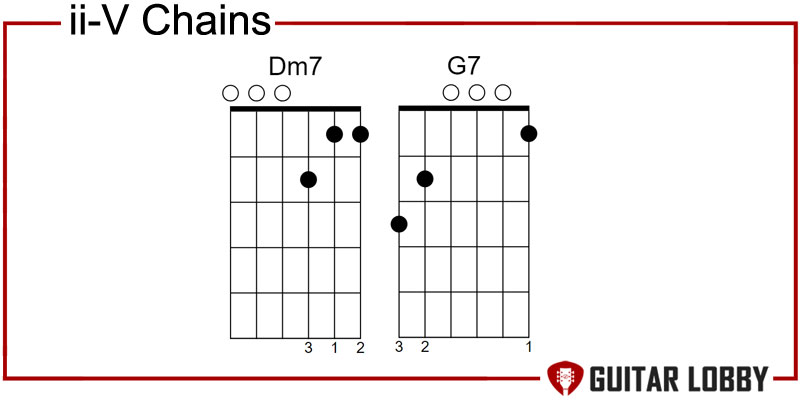
There are a few techniques that every aspiring jazz player should have under their fingers. The ii – V substitution is one such trick. We learned a while back that the ii – V – I is the most common progression in jazz. Being so ubiquitous also has a flip side: the progression can get boring. And jazz musicians don’t do boring. You’ll find them overcoming monotony by building in a series of ii – V into the standard progression.
A ii – V substitution essentially means you take a chord and place its supertonic (ii7) and dominant (V7) right before it. You can do this for one chord or a series of chords. Look at the example above where Dm7 – G7 acts as ii – V while resolving to the I or Cmaj7 chord. The same is happening to Dm7, which is again preceded by ii – V or Ebm7 – Ab7. This is also known as back cycling, where sequential ii – V progressions contain the dominant of the next chord.
In Roman numerals, this chromatically descending sequence would look like #ii – #V – ii – V – I.
Popular Songs That Use This Progression: “Satin Doll” (Duke Ellington) “Bye Bye Blackbird” (Miles Davis).
14. Tritone Substitution
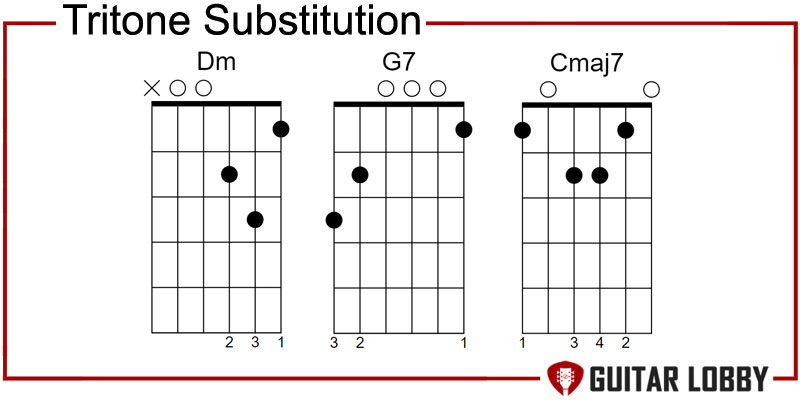
I am aware that tritone substitution is not a chord progression per se, but it can be used to spice up standard progressions. And this is what makes it such a popular harmonic device in jazz. It’s not a hard concept to come to grips with. It largely involves substituting one dominant chord or V with a dominant 7th chord whose root is a tritone interval (three whole steps) apart.
It turns out the two dominant chords that are a triton apart share two pitches: the 3rd and b7th, but inverted. The chromatic root movement produced by this substitution helps in reharmonizing, making it a useful tool for jazz comping and improvising.
Let’s say we’re in the key of C major, where the V is G7. Its tritone sub would be Db7. This technique is used to make any standard progression like ii – V – I or iii – VI – ii – V – I more interesting. A 2-5-1 in C is Dm – G7 – Cmaj7, but a tritone sub would turn it into Dm – Dbm7 – Cmaj7. It’s as simple as that!
15. I7 – IV7 – I7 – I7 – IV7 – IV7 – I7 – VI – ii – V – I7 – (ii – V) Jazz Blues Progression
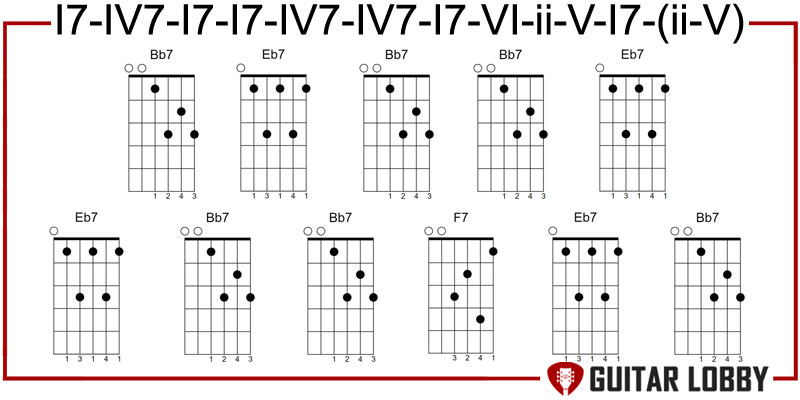
While blues and jazz are two different genres, you’ll find the two share many elements, including chord progressions, swing, and syncopated rhythms. Some of the most popular blues progressions, like the 12-bar blues, can be easily given a jazz spin by adding a jazz turnaround. Let’s take the most basic form of 12-bar blues, made up of only I7, IV7, and V7 chords. Here’s what it would look like
I7 – IV7 – I7 – I7 – IV7 – IV7 – I7- I7 – V7 – IV7 – I7 – (turnaround)
In the most basic form, a 12-bar blues would use just the V chord as a turnaround. So, if we were to apply this progression to the key of Bb, we’ll get:
Bb7 – Eb7 – Bb7 – Bb7 – Eb7 – Eb7 – Bb7 – Bb7 – F7 – Eb7 – Bb7 – (F7)
To give the basic 12-bar blues a jazzy flavor, we can introduce ii – V turnaround in bar 8. Now, instead of moving from the I7 chord in bar 8 to the V7 chord in bar 9, we will have the ii – V leading to the I7 chord. But jumping from chord I (Bb7) in bar 7 to a ii chord (Cm7) is a long gap. So, we will bring in the dominant VI chord or G7 to smoothen the shift. The final progression would be:
Bb7 – Eb7 – Bb7 – Bb7 – Eb7 – Eb7 – Bb7 – G7 – Cm7 – F7 – Bb7 – (Cm7 F7)
This is just one of the ways, and there are endless harmonic possibilities to turn a blues progression into jazz blues. You can also add more complexities, such as ending the progression with a Vi – ii – V turnaround or adding a ii – V going to IV7 in the 4th bar. You could also add the iii chord in the 8th bar and a #iv dim chord in the 6th bar. These changes will turn a simple jazz blues progression into something even more delightful, such as this:
Bb7 – Eb7 – Bb7 – (Fm7 Bb7) – Eb7 – E°7 – Bb7 – (Dm7 G7) – Cm7 – F7 – Bb7 – (G7 Cm7 F7)
16. Bird Blues Chord Progression
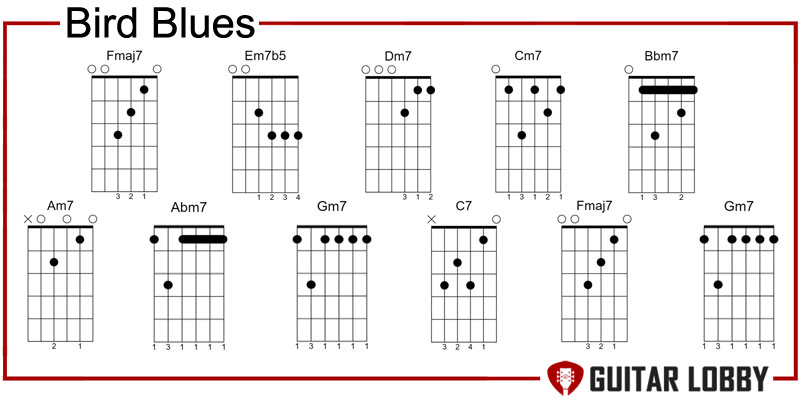
The Bird Blues or Bebop Blues was coined after its pioneer, Charlie Parker, aka ‘Bird.’ The famous saxophonist, along with other jazz icons like Dizzy Gillespie and Thelonious Monk, took classic blues forms and gave them a jazz makeover to create an irresistibly danceable Bebop style. Frantic chord changes, key changes, chord substitutions, extended chord structure, and syncopated rhythms dominated the Bebop era.
If you pick up a few iconic Bebop tunes, you’ll notice they use common blues progressions with fast chord changing and generous use of ii – Vs and tritone substitutions of dominant chords. One of the best examples of the Bird Blues progression is Parker’s “Blues for Alice.” The song is in the key of F major, and the chain of chords looks something like this:
Fmaj7 – (Em7b5 A7b9) – (Dm7 G7) – (Cm7 F7 Bb7) – (Bbm7 Eb7) – (Am7 D7) – (Abm7 Db7) – Gm7 – C7 – (Fmaj7 D7b9) – (Gm7 C7).
Unlike the traditional 12-bar blues with the I chord going to the IV chord in a straightforward fashion, Parker uses a sequential ii – Vs descending in whole steps to do the job. Another thing that’s different here is the use of the Imaj7 chord instead of the I7 chord.
In the next line, Parker employs target chords to connect the Bb7 chord in bar 5 to Gm7 in bar 9. Again, the chords sandwiched between are nothing but a series of descending ii – V7s.
In the final line, Parker rounds up the progression with an Imaj7 – VI7b9 – ii7 – V7, which is played over the last two measures. While the basic chord shapes shouldn’t take you too long to nail, it’s soloing over it that’s going to be the real challenge.
Popular Songs That Use This Progression: “Blues for Alice” (Charlie Parker), “Bluesettle” (Toots Thielemans), “Freight Trane” (Tommy Flanagan), “Confirmation” (Charlie Parker).
17. I – VI – ii – bII
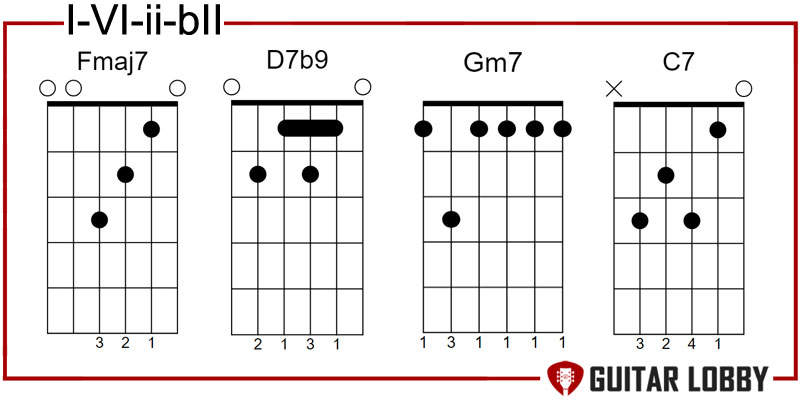
The importance of turnarounds in jazz cannot be overemphasized. They are the group of chords responsible for taking the sequence back to the tonic key. You’ll see them pop up at the end of a passage, usually over two bars, helping circle things back to the starting point. While I – VI – ii – V may be the most dependable turnaround, it can be further altered to create variations, like the I – VI – ii – bII.
The I – VI – ii – V is usually played as Imaj7 – vi7 – ii7 – V7. It can also be used as Imaj7 – VI7b9 – ii7 – V7, where VI7b9 acts as V7 of the following chord, which in this case is the ii7. This sequence in the key of F would become Fmaj7 – D7b9 – Gm7 – C7.
Now, we can go ahead and spice this up even more by ending the progression with a bII7 or Gb7 in place of V7 or C7. This is a classic example of tritone substitution we discussed a while back. You’re simply taking the C7 or V7 chord and replacing it with Gb7, which is a tritone interval away. The C7 and Gb7 chords share the same 3rd and the 7th, only reversed. That’s not all. The tritone substitution allows for a stronger resolution by half step, from Gb7 to Fmaj7.
18. iv7 – bVII – I Backdoor Progressions
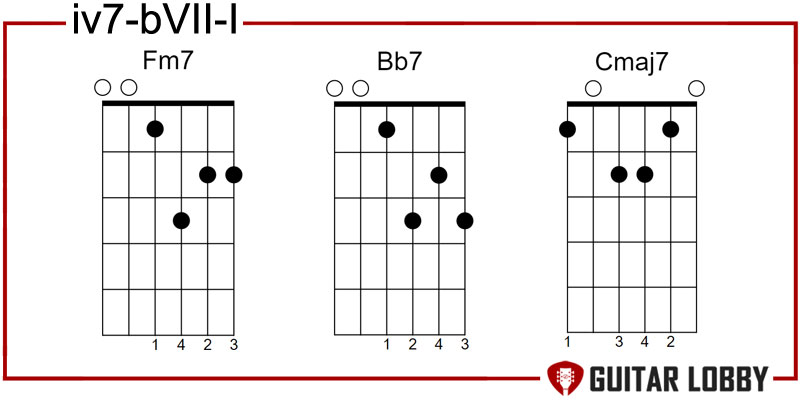
The V – I cadence is the strongest way to return to the tonic, but there are alternate routes to the same destination, like the plagal cadence or IV to I. In jazz, however, this cadence is used as iv7 to I, for creative reasons. But this can be made even more interesting through backdoor chord sequences.
A backdoor progression is a non-diatonic progression with chords that have notes that aren’t in the current major key. An example of a backdoor progression is an expansion of iv7 to I chord with a bVII chord, making the chain iv7 – bVII – I. So, where did the bVII come from? The bVII is a dominant chord lifted from the parallel minor key of the home key. You can think of it as a backdoor route to the V – I or ‘front door’ progression.
If the home key in the progression is C major, then the dominant G7 would be replaced with
Bb7. The backdoor progression would be Fm7 – Bb7 – Cmaj7. The reason why this works is because the two chords, V and bVII, share some common notes. In the key of C, G7 is made up of G, B, D, and F notes. Meanwhile, the Bb7 has Bb, D, F, Ab notes. As you can see, the two chords share D and F notes, making them similar in voice, leading to the Cmaj7 chord.
Jazz musicians always come up with unconventional twists to standard progressions and resolution, and borrowing a dominant chord from the parallel minor key is one way to do it.
Popular Songs That Use This Progression: “Stella by Starlight” (Victor Young), “How Deep is the Ocean” (Chet Baker and Paul Desmond), “Yardbird Suite” (Charlie Parker).
Chord Progressions Found in Jazz Standards – 7 Examples
We’ve already looked at some jazz standards in the previous section, like “I Got Rhythm” and “Blues for Alice.” These songs were home to genre-defining chord progressions. It’s time to look at more real-life jazz examples that use the chord sequences we’ve seen in this list.
19. Blue Bossa
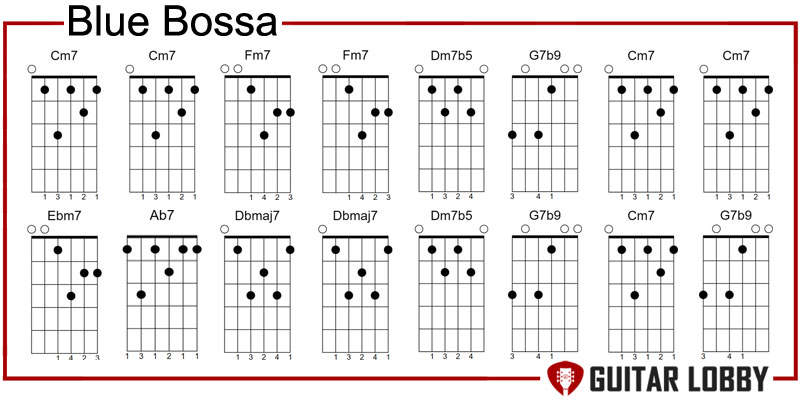
“Blue Bossa” is a Bossa Nova-meets-hard bop tune composed by iconic jazz trumpet player Kenny Dorham. It was later made famous by Joe Anderson in 1963. This 16-bar tune is in the key of C minor, so it utilizes the minor version of the standard II – V – I progression.
The chord progression of “Blue Bossa” is:
Cm7 – Cm7 – Fm7 – Fm7 – Dm7b5 – G7b9 – Cm7 – Cm7 – Ebm7 – Ab7 – Dbmaj7 – Dbmaj7 – Dm7b5 – G7b9 – Cm7 – G7b9.
For the most part, the chords stay in the key of C minor. The progression only modulates to the Db major key in bars 9 -12 before going back to C minor. Notice how the chords Ebm7 – Ab7 – Dbmaj7 follow the classic ii – V – I sequence.
As a musical style, Bossa Nova is a mix of samba and jazz. Think of it as Latin or Brazilian rhythm elements blended with complex jazz harmonies. Needless to say, picking up a few Bossa standards will broaden and deepen your jazz repertoire.
20. Autumn Leaves
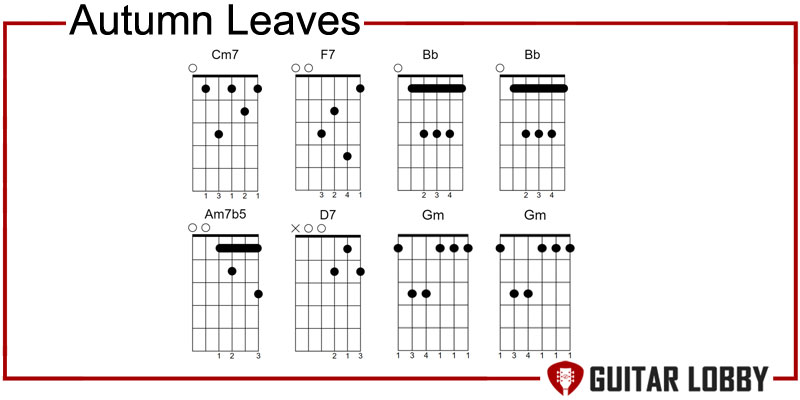
Along with “I Got Rhythm,” “Autumn Leaves” is one jam you’d find on every beginner jazz musician’s list of tunes to master. For starters, the chord sequence is pretty straightforward, which is a rarity in jazz. Also, there are thousands of step-by-step tutorials floating online to walk you through this iconic piece. So, let me also make myself useful and give you a rundown of the chord sequences in this song.
There’ve been countless renditions of “Autumn Leaves,” which was originally composed by Joseph Kosma and Jacques Prevert. The tune was introduced in the jazz circles by Miles Davis when he recorded his cover. Playing-wise, it’s a masterclass in moving back and forth between a major key and its relative minor key.
You’ll usually find it performed either in the key of G and its relative minor Em or the key of Bb and Gm. It’s a 32-bar progression in the less common AABC song form. You could think of it as four 8-bar progressions. In Bb major/G minor, the chord progression in section A is as follows:
Cm7 – F7 – Bb – Bb
Am7b5 – D7 – Gm – Gm.
See how every four bars are just ii – V – I progressions. While the four bars are ii – V – I in the key of Bb, the second set of 4 bars are in the key of G minor. Since. It’s an AABC form; this 8-bar progression repeats over the next 8 bars. However, the B section starts with a ii – V – I in G minor, followed by the same in B flat major. The last section is just ii – V – I in G minor, performed twice.
21. Girl from Ipanema / Take the A Train
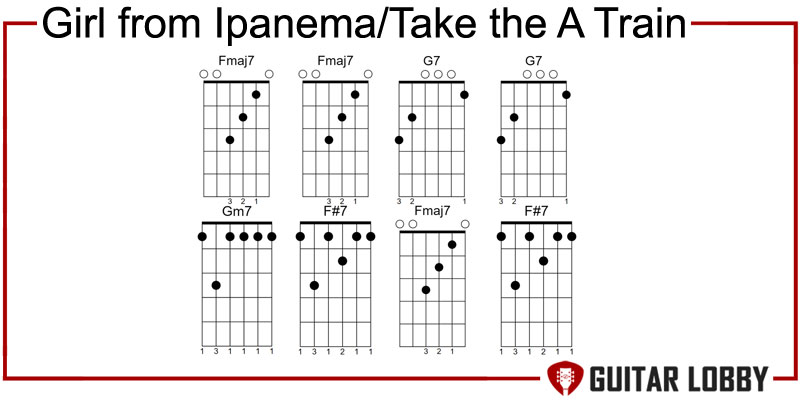
Let’s follow up the awesomeness of Autumn leaves with another timeless jazz hit, “Girl from Ipanema,” made famous by Frank Sinatra. The song uses Imaj7 – II7 and ii7 – V7 – Imaj7 chord sequence. This motion where the Imaj7 chord goes to the II7 and then ii7 is quite common in jazz. In the first section of Sinatra’s “Girl from Ipanema,” the chord progression Imaj7 – II7 – ii7 – V7 – Imaj7 is in the key of F major, and this is what it looks like
Fmaj7 – Fmaj7 – G7 – G7 – Gm7 – F#7 – Fmaj7 – F#7
The dominant, or C7, is replaced here using tritone substitution with F#7.
You’ll also find this progression in the ultra-popular 32-bar AABA form classic “Take the A Train” by Duke Ellington. Here’s the second section of Ellington’s classic that follows a similar sequence:
Cmaj7 – Cmaj7 – D7b5 – D7b5 – Dm7 – G7 – Cmaj7 – C7
It’s similar but not the same because there’s something else happening here. Can you tell? It’s the D7b5 chord, which is an altered dominant 7th chord. The use of chord extensions and altered chords helps jazz musicians venture away from the boring diatonic chords, adding more flavor and richness in the process. It’s a fairly common jazz chord progression and one you’ll see in many jazz songs.
22. Stella by Starlight
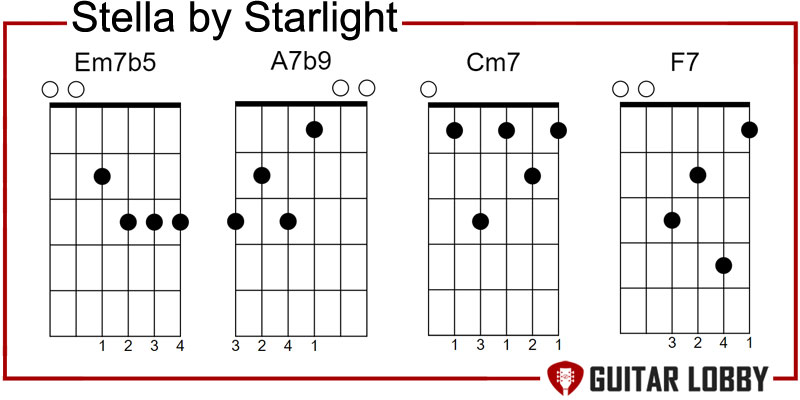
We saw an example of a backdoor progression in the last section, where we took the bVII route to go back to the tonic instead of the standard V – I resolution. It’s time to discuss a real-life example of the progression as heard in the jazz standard “Stella by Starlight.” The tune was originally written by Victor Young way back in the 1940s. Since then, it’s been recorded by jazz greats like Miles Davis, Ella Fitzgerald, and Chet Baker.
The backdoor progression bVII7 goes to the Imaj7 chord in bars 8-9 without the II chord before it. It simply moves from Ab7 to the Bbmaj7. The second time this backdoor sequence shows up is in bars 21-24 but is slightly altered with the bVII(#11) chord resolving to the Imaj7 chord.
Like most jazz standards, “Stella by Starlight” also houses a 32-bar, but in a rather unconventional ABCA form. It’s a tricky tune to learn with a fair share of unusual chord chains. But it opens up the doors to an exciting world of improv, such as using guide tones (3rd and 7th notes of a chord) and melodic minor scales to play over these progressions.
23. West Coast Blues
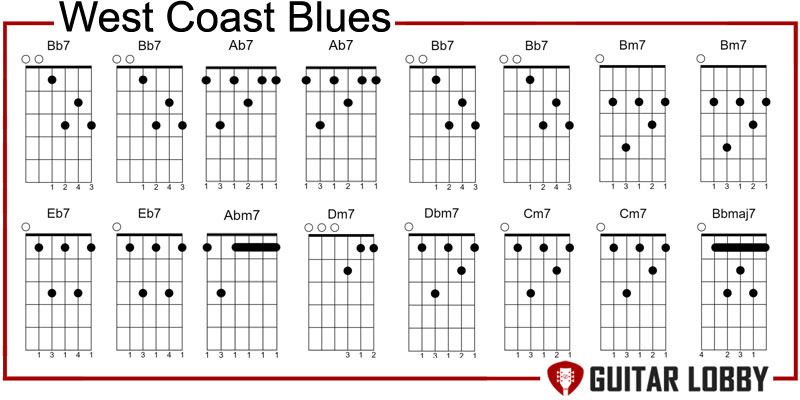
Blues, among a few other genres, played an important role in the genesis of jazz. The two styles go way back, and most jazz musicians make it a point to dabble in blues. We’ve already gone over jazz blues progressions in the previous section. Let’s check out a real-life example of jazz blues with Wes Montgomery’s West Coast Blues.
Here’s what the sequence in Bb major key looks like:
Bb7 – Bb7 – Ab7 – Ab7 – Bb7 – Bb7- Bm7 – E7 – Eb7 – Eb7 – (Abm7 Ab7) – (Dm7 G7) – (Dbm7 Gb7) – (Cm7 F7) – (Cm7 F7) – (Bbmaj7 Db7) – (Gbmaj7 B7)
In this track, the legendary jazz guitarist took a traditional 12-bar blues progression and extended it into a 24-bar sequence in 3/4 time. The resulting blues sequence was teeming with chromatic ii – Vs, as you can see in bars 11-16. There are plenty of jazz elements you’ll encounter when you get down to learning this piece, including turnarounds, key changes, and borrowed chords.
24. Satin Doll
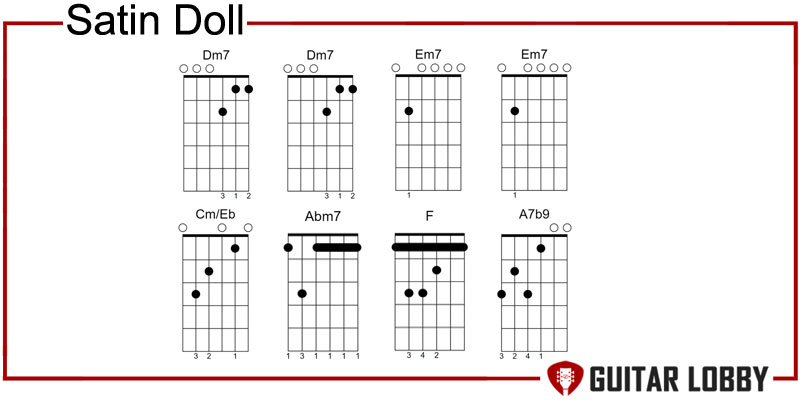
“Satin Doll” is a ii – V workout. It’s sprinkled with chains of non-resolving ii – Vs throughout, as well as the II – V – I. The iconic jazz piece was written by Duke Ellington and Billy Strayhorn and later covered Ella Fitzgerald, Wes Montgomery, Oscar Peterson, and Nancy Wilson, to name a few.
More often than not, you’ll find this piece being performed in the key of C major. It’s a 32-bar progression in the common AABA form, where the A section occurs twice, followed by the B section or the bridge, ending with the A section. Each section is 8 bars long.
The progression in the A section is as follows:
(Dm7 G7) – (Dm7 G7) – (Em7 A7) – (Em7 A7) – (Cm/Eb D7) – (Abm7 Db7b9 C6) – (F Em7) – A7b9
Notice how the progression starts with Dm7 to G7, then moves to Em7 to Am7, and so on. As I mentioned earlier, this song is great for practicing ii – Vs as well as learning to solo over these chord changes. I also recommend getting familiar with Shell Voicings. Shell chords are chords reduced to just the root, the 3rd, and the 7th. These bare necessities jazz chords are easy to play and offer plenty of room to add extensions (like 9th and 13th). Employing shell voicings instead of basic chord shapes helps in coming up with creative comping rhythms.
25. Misty
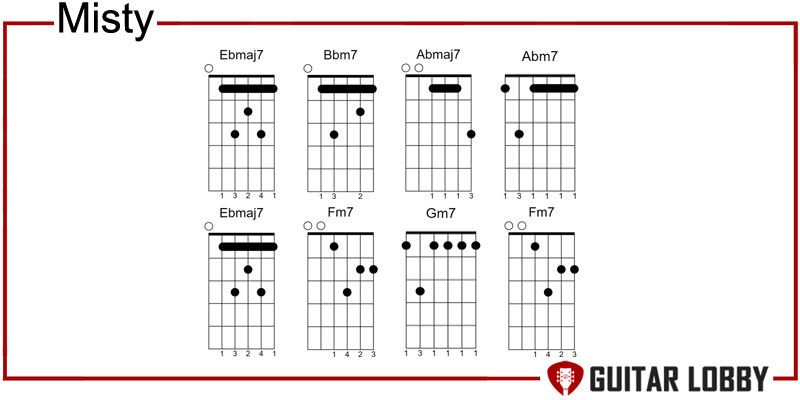
Errol Garner’s “Misty” is a jazz tune where you’ll find several of the chord sequences we’ve gone over today: ii – Vs, II – V – I, I – VI – II – V. It’s a 32-bar tune structured in the common AABA form like “Satin Doll.” It starts in the key of Eb, changing its key along the way. And here’s what the first section looks like:
Ebmaj7 – (Bbm7 Eb7) – AbMaj7 – (Abm7 Db7)
(Ebmaj7 Cm7) – (Fm7 Bb7) – (Gm7 C7) – (Fm7 Bb7)
The progression kicks off with the Ebmaj7 chord, followed by Bbm7- Eb7 – Abmaj7 over bars 2 and 3. This is the classic II – V – I progression in Abmaj7 key. Bar 4 is made up of a non-resolving ii – V in the key of Gb. Bar 5 and 6 houses another popular sequence we encountered today: I – vi – ii – V in Eb. The first section of “Misty” concludes with III – VI7 – II – V7 progression in Eb.
There you have it! “Misty” is the perfect song to recap some of the most common progressions in the genre.
Wrapping Up:
We’ve gone over 25 amazing chord progressions that are essential to building an expansive repertoire of jazz standards as well as writing your groovy tunes. Mastering these will help you navigate the boundless world of jazz a bit more easily. For some of you, the progressions and techniques discussed here will also act as a jumping-off point into jazz improv. Whatever your jazz goal may be, we hope this article helped you inch a bit closer to it.

My name is Chris and I’ve had a passion for music and guitars for as long as I can remember. I started this website with some of my friends who are musicians, music teachers, gear heads, and music enthusiasts so we could provide high-quality guitar and music-related content.
I’ve been playing guitar since I was 13 years old and am an avid collector. Amps, pedals, guitars, bass, drums, microphones, studio, and recording gear, I love it all.
I was born and raised in Western Pennsylvania. My background is in Electrical Engineering, earning a Bachelor’s degree from Youngstown State University. With my engineering experience, I’ve developed as a designer of guitar amplifiers and effects. A true passion of mine, I’ve designed, built, and repaired a wide range of guitar amps and electronics. Here at the Guitar Lobby, our aim is to share our passion for Music and gear with the rest of the music community.

